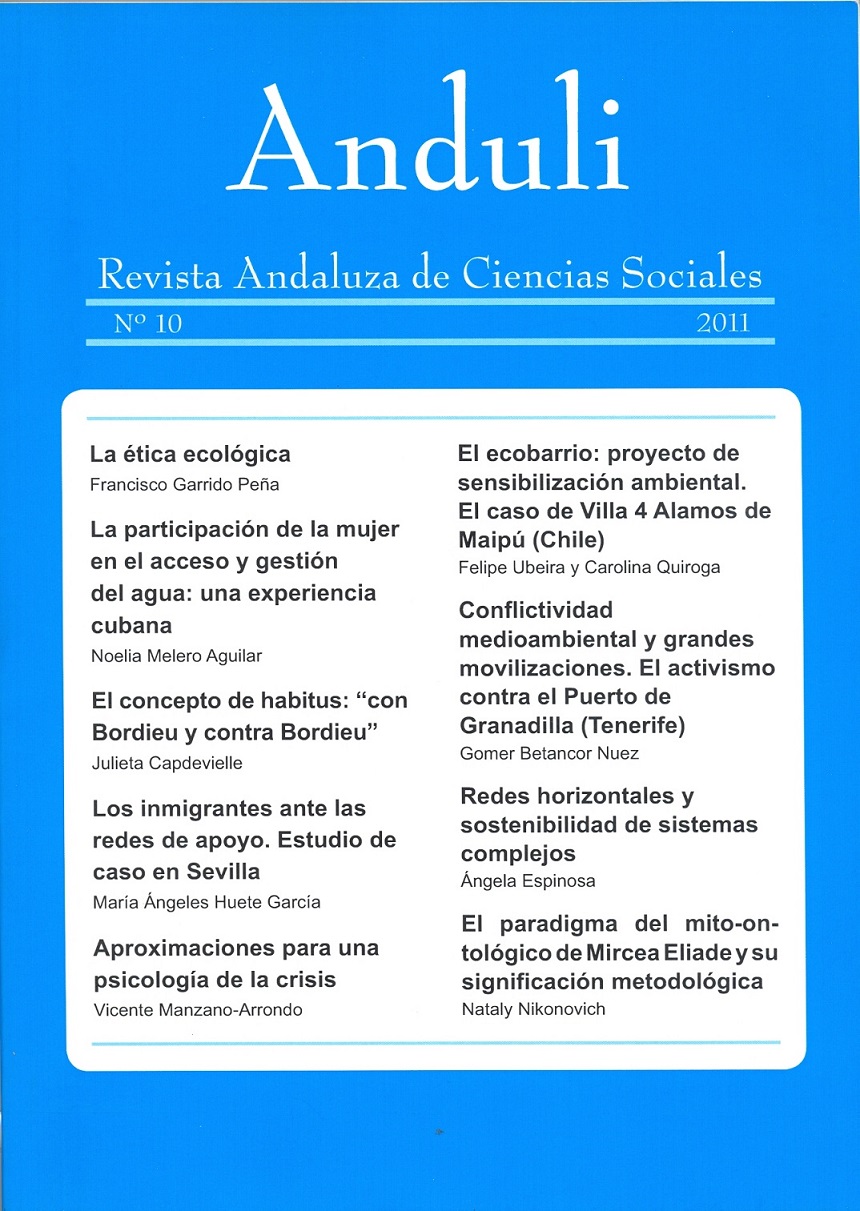THE RELATIONSHIP OF INMIGRANTS WITH SUPPORT NETWORKS. A case study in Seville
Keywords:
Immigration, support networks, multi intercultural neighborhood, demographic profile, source network, destination network, formal network, informal network, social integration, material issues, immaterial issuesAbstract
This paper is an analysis of the different ways of access to social networks -formal and informal, by country of origin and destination- affecting immigrants in the city of Seville. In order to do so, the theoretical framework about social networks has been applied to data obtained from a survey carried on with the immigrant population during 2009 in eleven districts of the city of Seville. The survey was conducted by the Center for Sociology and Politics of the local University Pablo de Olavide, as part of the “Diagnosis of the immigrant population in the city of Seville”, held at the request of the Delegation of Institutional Relations of the Townhall of the City of Seville. Through an analysis of correlations the sociodemographic characteristics (nationality, educational level, area of residence, length of stay in the country, financial resources etc..)have been combined with the different types of networks used by immigrants, as well as their priorities in solving material or immaterial problems, in the city of Seville in 2009. The results confirmed important differences in the use of formal networks by immigrants of different nationalities, as well as the types of issues for which assistance is requested in view of the resources available to the individual. It also clarifies the weakness shown by some of the correlations, opening the way to an exploration of new aspects that require being studied, as well as comparisons with similar studies, to shed additional light on the processes involved in this is sue of great social interest but relatively new in our cities.
Downloads
Metrics
References
Aparicio, R. y A. Tornos (2005): Las redes sociales de los inmigrantes extranjeros en España. Madrid. Ministerio de Trabajo y Asuntos Sociales.
Coleman, J.S. (1988): Social capital in the creation of human capital. American Journal of Sociology (94): 95-120.
Granovetter, M. (1982). The Strengh of Weak Ties , Social Structure of Weak Ties. P.V. Marsden y N. Din. California. Sage Publications Ltd 105-130.
Martinez García, M.F., M. García Ramírez y I. Maya Jariego (2001): Una tipología analítica de las redes de apoyo social en inmigrantes africanos en Andalucía REIS (95): 99-125.
Martinez García, M.F., M. García Ramírez y I. Maya Jariego (2002): Social support and locus of control as predictors of psycological well-being in Moroccan and Peruvian inmigrant women in Spain. International Journal of Intercultural Relations (26): 287-310.
García Almirall, P. y A. Frizzera (2008): La trayectoria residencial de la inmigración en Madrid y Barcelona. Un esquema teórico a partir del análisis cualitativo. ACE. Año III. Número 8. Octubre 2008.
Maya Jariego, I. (2001): Tipos de redes personales de los inmigrantes y adaptación psicológica. Revista Redes 1.
Maya Jariego, I., M.F. Martínez García y M. García (1999): Cadenas migratorias y redes de apoyo social de las mujeres peruanas en Sevilla. Demofilo. Revista de Cultural Tradicional de Andalucía (29): 87-105.
Portes, A. y J. Sensenbrenner (1993): Embeddedness and inmigration: notes of the social determinants of economic action American Journal of Sociology 98 (6): 1320-50.
Downloads
Published
How to Cite
Issue
Section
License
The printed and electronic editions of this Journal are published by Editorial Universidad de Sevilla, and it is necessary to cite the source in any partial or total reproduction.
Unless otherwise indicated, all contents of the electronic edition are distributed under a "Creative Commons Attribution-NonCommercial-NoDerivative 4.0 International" license. You can consult from here the informative version and the legal text of the license. This circumstance must be expressly stated in this way when necessary.
The authors who publish in this journal accept the following conditions:
1. The authors retain the copyright and assign to the journal the right of first publication, with the work registered with the license of attribution of Creative Commons, which allows third parties to use what has been published as long as they mention the authorship of the work and the first publication in this journal.
2. Authors may make other independent and additional contractual agreements for non-exclusive distribution of the version of the article published in this journal (e.g., inclusion in an institutional repository or publication in a book) as long as they clearly indicate that the work was first published in this journal.
3. Authors are allowed and encouraged to publish their work on the Internet (e.g., on institutional or personal pages) before and during the review and publication process, as this may lead to productive exchanges and greater and faster dissemination of the published work (see The Effect of Open Access).
- Abstract 577
- PDF (Español (España)) 305





